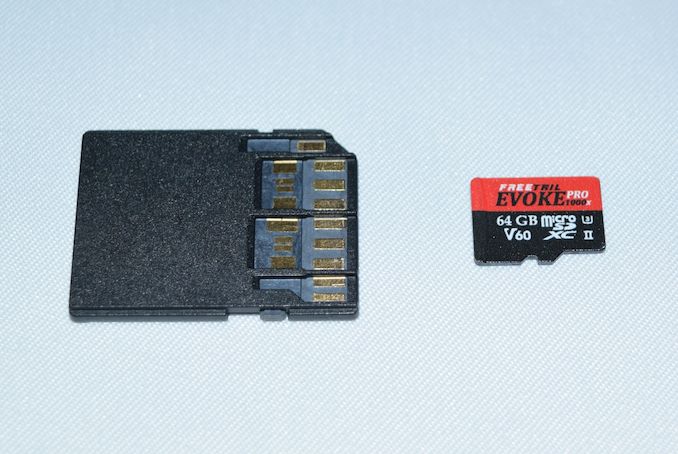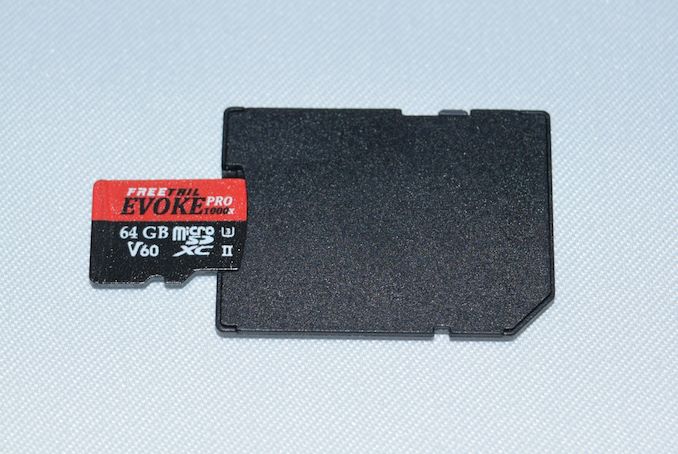
Original Link: https://www.anandtech.com/show/13622/freetail-evoke-pro-microsdxc-uhsii-memory-card-capsule-review
FreeTail EVOKE Pro microSDXC UHS-II Memory Card Capsule Review
by Ganesh T S on November 20, 2018 2:00 PM EST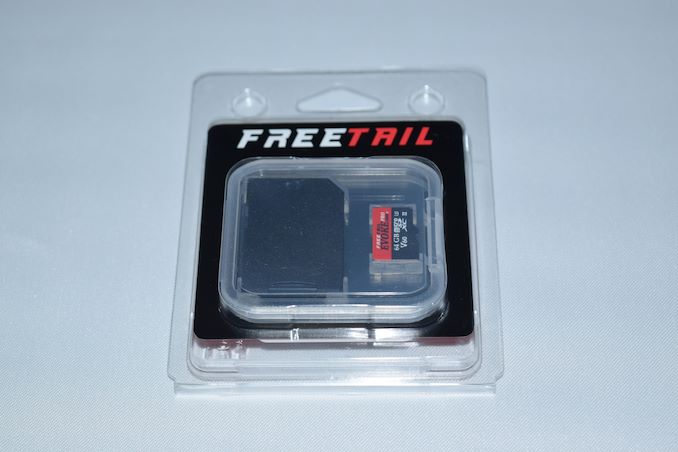
Almost all content capture devices employ memory cards (flash-based removable media) for storage. Hand-held consoles and many other computing systems (PCs as well as smartphones) also employ them for augmenting the available storage capacity. There are different varieties of memory cards catering to various performance levels. CompactFlash (CF) became popular in the late 90s, but, has now been overtaken by Secure Digital (SD) and its smaller form-factor version (microSD). We recently started in-depth evaluation of the performance of various memory cards. FreeTail sent over their UHS-II microSDXC card for inclusion in our performance database.
Introduction
SD (Secure Digital) cards were introduced in 1999, as an update to the existing MultiMediaCards (MMCs). It gained traction even in areas where CompactFlash had been preferred, thanks to its small size. Its popularity is evident by the fact that it has spawned two follow-ups in the same form factor - starting with the SDSC in 1999 for capacities between 1MB and 2GB, we got SD High Capacity (SDHC) in 2006 (up to 32GB) and SD eXtended Capacity (SDXC) in 2009 (up to 2TB). The cards also come in various sizes - standard, mini, and micro. Along with the capacity, the performance has also seen an upward curve. While UHS-I had an upper theoretical limit of around 100 MBps, UHS-II added more pins and increased the theoretical limit to around 312 MBps.
FreeTail's SDXC and microSDXC UHS-II/U3 lineup comes under the EVOKE Pro category. While the SDXC version has three members - 64GB, 128GB, and 256GB, the microSDXC set comes in at 32GB, 64GB, and 128GB.
Today's review takes a look at the 64GB microSDXC version.
Testbed Setup and Testing Methodology
Evaluation of memory cards is done on Windows with the testbed outlined in the table below. The USB 3.1 Type-C port enabled by the Intel Alpine Ridge controller connects to the Z170 PCH via a PCIe 3.0 x4 link. is used for benchmarking purposes on the testbed side. uSD cards utilize the Lexar Professional Workflow SR2 SDHC / SDXC UHS-II USB 3.0 Reader along with the microSD to SD adapter supplied by the card vendor. The reader was placed in the Lexar Professional Workflow HR2 hub and uplinked through its USB 3.0 port with the help of a USB 3.0 Type-A female to Type-C male cable.
| AnandTech DAS Testbed Configuration | |
| Motherboard | GIGABYTE Z170X-UD5 TH ATX |
| CPU | Intel Core i5-6600K |
| Memory | G.Skill Ripjaws 4 F4-2133C15-8GRR 32 GB ( 4x 8GB) DDR4-2133 @ 15-15-15-35 |
| OS Drive | Samsung SM951 MZVPV256 NVMe 256 GB |
| SATA Devices | Corsair Neutron XT SSD 480 GB Intel SSD 730 Series 480 GB |
| Add-on Card | None |
| Chassis | Cooler Master HAF XB EVO |
| PSU | Cooler Master V750 750 W |
| OS | Windows 10 Pro x64 |
| Thanks to Cooler Master, GIGABYTE, G.Skill and Intel for the build components | |
The full details of the reasoning behind choosing the above build components can be found here.
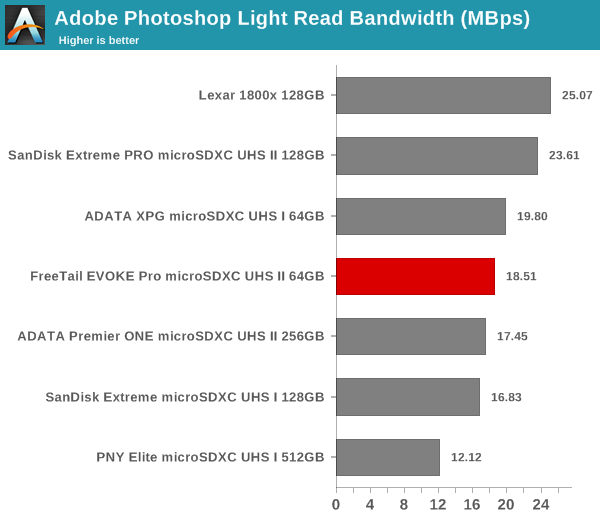
In both sets of performance graphs, we see that the FreeTail EVOKE Pro comes in the middle of the pack - better than the ADATA Premier ONE, but, not as good as the SanDisk Extreme PRO.
Performance Restoration
The traditional memory card use-case is to delete the files on it after the import process is completed. Some prefer to format the card either using the PC, or, through the options available in the camera menu. The first option is not a great one, given that flash-based storage devices run into bandwidth issues if garbage collection (processes such as TRIM) is not run regularly. Different memory cards have different ways to bring them to a fresh state.Based on our experience, uSD cards have to be formatted using the SD Formatter tool from the SD Association (after all the partitions are removed using the 'clean' command in diskpart).
In order to test out the effectiveness of the performance restoration process, we run the default sequential workloads in CrystalDiskMark before and after the formatting. Note that this is at the end of all our benchmark runs, and the card is in a used state at the beginning of the process. The corresponding screenshots for similar cards that we have evaluated before is available via the drop-down selection.
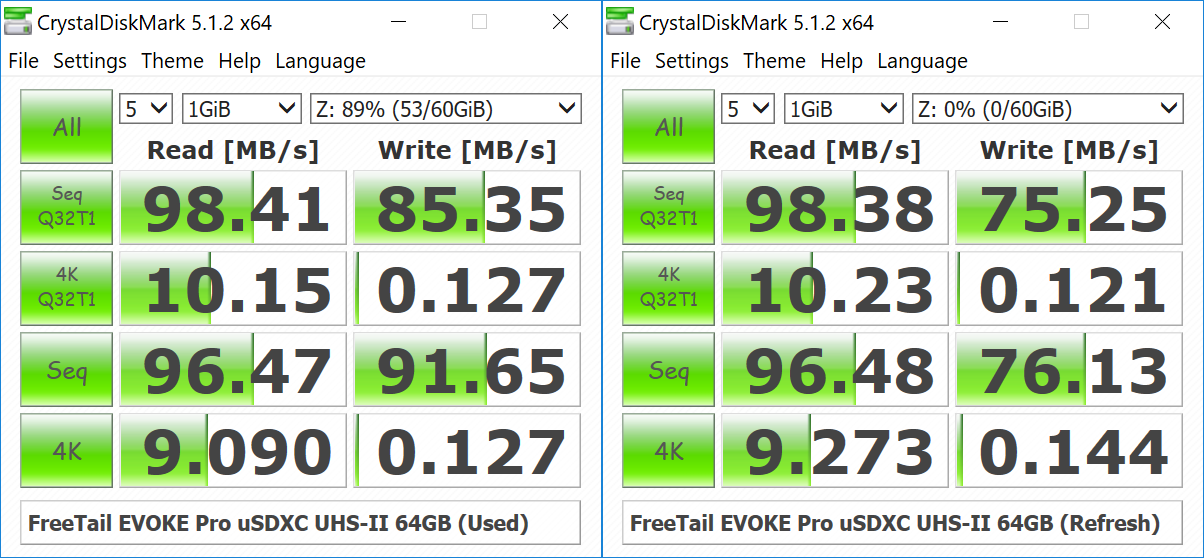
Despite using the SD Formatter Tool, the write performance doesn't get back to the fresh state after a complete refresh. This is unlike the experience we had with the other microSDXC UHS-II cards. The read performance is unaffected, though.
Concluding Remarks
Our benchmark and consistency numbers have shown that the FreeTail EVOKE Pro UHS-II microSDXC card comes between the ADATA Premier ONE and the SanDisk Extreme PRO in terms of performance. In the long term, we would be wary of using it in content capture devices - maybe for a few months of heavy capture workloads would be fine. But, the consistency of the reads show that the card may hold promise for other workloads such as usage in the Nintendo Switch. We will need to look at the value proposition to make a final judgement on that.
In addition to raw performance and consistency, pricing is also an important aspect. This is particularly important in the casual user and semi-professional markets, where the value for money metric often trumps benchmark numbers. The table below presents the relevant data for the FreeTail EVOKE Pro microSDXC UHS II 64GB uSD card and other similar ones that we have evaluated before. The cards are ordered by the $/GB metric.
| uSD Cards - Pricing (as on 18th Nov. 2018) | ||||
| Card | Model Number | Capacity (GB) | Street Price (USD) | Price per GB (USD/GB) |
| SanDisk Extreme microSDXC UHS I 128GB | SDSQXAF-128G-GN6MA | 128 | 49 | 0.38 |
| PNY Elite microSDXC UHS I 512GB | P-SDU512U190EL-GE | 512 | 350 | 0.68 |
| ADATA XPG microSDXC UHS I 64GB | AUSDX64GXUI3-RA1 | 64 | 50 | 0.78 |
| FreeTail EVOKE Pro microSDXC UHS II 64GB | FTUD064A10 | 64 | 56 | 0.88 |
| ADATA Premier ONE microSDXC UHS II 256GB | AUSDX256GUII3CL10-C | 256 | 286 | 1.12 |
| Lexar 1800x 128GB | LSDMI128CRBNA1800R | 128 | 167 | 1.30 |
| SanDisk Extreme PRO microSDXC UHS II 128GB | SDSQXPJ-128G-GN6M3 | 128 | 208 | 1.63 |
The FreeTail EVOKE Pro is the cheapest UHS-II microSDXC card we have seen in the market. In terms of performance per dollar, the card is well-ahead of the competition. The only thing that prevents us from giving it an unqualified recommendation is the consistency of writes after extended usage. For read-heavy workloads such as usage in handheld gaming consoles, the FreeTail EVOKE Pro microSDXC UHS-II cards are a perfect fit.

